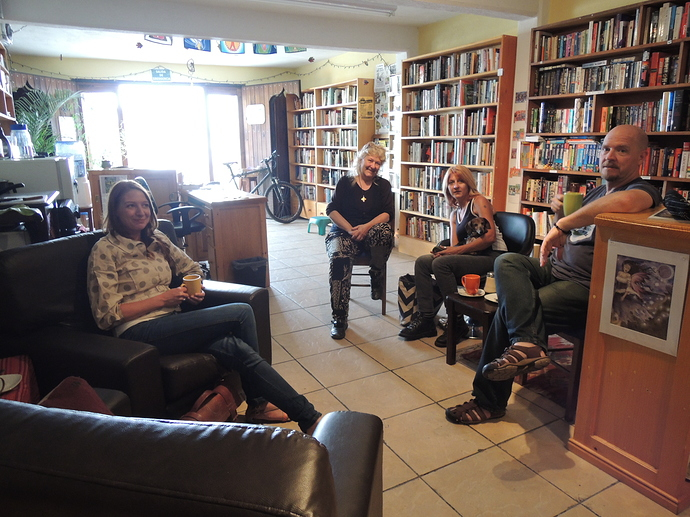I don’t share or print most of my photos because they take so much work, which is unfortunate. I am not good at backing up either, so most of them are gone. I have learned to take smarter photos and print them right away, making sure that I expose my subjects well and that I modify or frame the scene as best as I can.
Take, for instance, the image that you shared. I would have drawn the blinds, or frame it from another direction. But you can’t go back in time…
Personally, I think there is no easy (i.e., fast, bulk) solution to images of scenes with high dynamic range. However, once you create a strategic workflow and use it often, you will eventually get the hang of it.
This is what I came up with: I used a custom G’MIC sequence of commands but you could do it using GIMP. It is more of a discussion really than a method.
1. I look at my subjects. There are 4 people in the room. As the others have said, they are well exposed.
Original image

Some statistics won’t hurt, though you need to know what they mean. Observe the following chart, where 0 is black, 1 is white and the values are the averages:
| face |
colour |
grey (norm) |
| L |
0.392 |
0.496 |
|
0.445 |
0.507 |
|
0.409 |
0.413 |
| R |
0.349 |
0.373 |
I want to brighten their faces just a bit more.
Another observation is that the blown out area is large and domineering. I really need to control that area. I need to darken it or at least keep it the same as I brighten the rest of the image.
2. There are as many strategies as there are people in this forum, including hands on local manipulation using GIMP or Krita or a raw processor with local region capabilities.
I am not very good at that unfortunately. Hence, I ended up with taking advantage of curves and doing a version of luminosity masking (not my method but this tutorial is helpful: [Youtube] - Selecting using Luminosity Masks), which takes away the challenge of manual masking and painting. Perhaps, a combination of the two is best for optimal results.
There is also tone mapping (see tutorial: How to realistically brighten shadows in GIMP - Mantiuk and Retinex in G'MIC).
Basically, I took the original image. Call it A. Duplicated it thrice B, C and D. A is the reference layer that I won’t touch. B is the layer that I will darken. C is the layer I will brighten to the target values I would like the faces to be in. And D is the layer I will create a luminosity or whatever mask to blend B and C together to make E. Then I edit E to taste. For the result below, I simply increased the contrast.
Resultant image – the foreground should now be brighter with more contrast and the blown area should be about the same. (The background was darker before the contrast curve.) I did this in reference to the subjects’ faces.

Not the best work but hopefully you can see what is possible.





